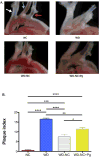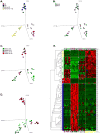Distinct roles for dietary lipids and Porphyromonas gingivalis infection on atherosclerosis progression and the gut microbiota
- PMID: 28442421
- PMCID: PMC5521207
- DOI: 10.1016/j.anaerobe.2017.04.011
Distinct roles for dietary lipids and Porphyromonas gingivalis infection on atherosclerosis progression and the gut microbiota
Abstract
Mounting evidence in humans supports an etiological role for the microbiota in inflammatory atherosclerosis. Atherosclerosis is a progressive disease characterized by accumulation of inflammatory cells and lipids in vascular tissue. While retention of lipoprotein into the sub-endothelial vascular layer is believed to be the initiating stimulus leading to the development of atherosclerosis, activation of multiple pathways related to vascular inflammation and endothelial dysfunction sustain the process by stimulating recruitment of leukocytes and immune cells into the sub-endothelial layer. The Gram-negative oral pathogen Porphyromonas gingivalis has been associated with the development and acceleration of atherosclerosis in humans and these observations have been validated in animal models. It has been proposed that common mechanisms of immune signaling link stimulation by lipids and pathogens to vascular inflammation. Despite the common outcome of P. gingivalis and lipid feeding on atherosclerosis progression, we established that these pro-atherogenic stimuli induced distinct gene signatures in the ApoE-/- mouse model of atherosclerosis. In this study, we further defined the distinct roles of dietary lipids and P. gingivalis infection on atherosclerosis progression and the gut microbiota. We demonstrate that diet-induced lipid lowering resulted in less atherosclerotic plaque in ApoE-/- mice compared to ApoE-/- mice continuously fed a Western diet. However, the effect of diet-induced lipid lowering on plaque accumulation was blunted by P. gingivalis infection. Using principal component analysis and hierarchical clustering, we demonstrate that dietary intervention as well as P. gingivalis infection result in distinct bacterial communities in fecal and cecal samples of ApoE-/- mice as compared to ApoE-/- mice continuously fed either a Western diet or a normal chow diet. Collectively, we identified distinct microbiota changes accompanying atherosclerotic plaque, suggesting a future avenue for investigation on the impact of the gut microbiota, diet, and P. gingivalis infection on atherosclerosis.
Keywords: Atherosclerosis; Gut microbiota; Immunity; Inflammation; Lipids; Oral microbiota.
Copyright © 2017 Elsevier Ltd. All rights reserved.
Figures






Similar articles
-
Distinct gene signatures in aortic tissue from ApoE-/- mice exposed to pathogens or Western diet.BMC Genomics. 2014 Dec 24;15(1):1176. doi: 10.1186/1471-2164-15-1176. BMC Genomics. 2014. PMID: 25540039 Free PMC article.
-
Oral infection with a periodontal pathogen alters oral and gut microbiomes.Anaerobe. 2021 Oct;71:102399. doi: 10.1016/j.anaerobe.2021.102399. Epub 2021 Jul 29. Anaerobe. 2021. PMID: 34090994
-
Western diet feeding influences gut microbiota profiles in apoE knockout mice.Lipids Health Dis. 2018 Jul 18;17(1):159. doi: 10.1186/s12944-018-0811-8. Lipids Health Dis. 2018. PMID: 30021609 Free PMC article.
-
Engagement of specific innate immune signaling pathways during Porphyromonas gingivalis induced chronic inflammation and atherosclerosis.Front Biosci. 2008 Jan 1;13:2041-59. doi: 10.2741/2822. Front Biosci. 2008. PMID: 17981690 Review.
-
Role of gut microbiota in atherosclerosis.Nat Rev Cardiol. 2017 Feb;14(2):79-87. doi: 10.1038/nrcardio.2016.183. Epub 2016 Dec 1. Nat Rev Cardiol. 2017. PMID: 27905479 Review.
Cited by
-
Polyphenols-Gut-Heart: An Impactful Relationship to Improve Cardiovascular Diseases.Antioxidants (Basel). 2022 Aug 30;11(9):1700. doi: 10.3390/antiox11091700. Antioxidants (Basel). 2022. PMID: 36139775 Free PMC article. Review.
-
Diet-Induced Non-alcoholic Fatty Liver Disease and Associated Gut Dysbiosis Are Exacerbated by Oral Infection.Front Oral Health. 2022 Jan 24;2:784448. doi: 10.3389/froh.2021.784448. eCollection 2021. Front Oral Health. 2022. PMID: 35141703 Free PMC article.
-
Periodontitis and Other Risk Factors Related to Myocardial Infarction and Its Follow-Up.J Clin Med. 2022 May 6;11(9):2618. doi: 10.3390/jcm11092618. J Clin Med. 2022. PMID: 35566746 Free PMC article.
-
Oral-gut axis as a novel biological mechanism linking periodontal disease and systemic diseases: A review.Jpn Dent Sci Rev. 2023 Dec;59:273-280. doi: 10.1016/j.jdsr.2023.08.003. Epub 2023 Aug 28. Jpn Dent Sci Rev. 2023. PMID: 37674899 Free PMC article. Review.
-
Gut microbiota and derived metabolites mediate obstructive sleep apnea induced atherosclerosis.Gut Microbes. 2025 Dec;17(1):2474142. doi: 10.1080/19490976.2025.2474142. Epub 2025 Mar 2. Gut Microbes. 2025. PMID: 40025767 Free PMC article.
References
-
- Hansson GK. Inflammation, atherosclerosis, and coronary artery disease. N Engl J Med. 2005;352(16):1685–95. - PubMed
-
- Kiechl S, et al. Chronic infections and the risk of carotid atherosclerosis: prospective results from a large population study. Circulation. 2001;103(8):1064–70. - PubMed
-
- Li L, et al. Porphyromonas gingivalis infection accelerates the progression of atherosclerosis in a heterozygous apolipoprotein E-deficient murine model. Circulation. 2002;105(7):861–7. - PubMed
MeSH terms
Grants and funding
LinkOut - more resources
Full Text Sources
Other Literature Sources
Medical
Miscellaneous

